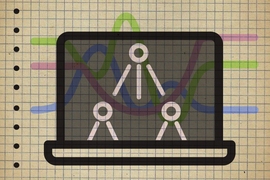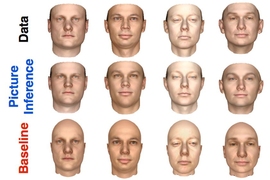A team of MIT researchers is making it easier for novices to get their feet wet with artificial intelligence, while also helping experts advance the field.
In a paper presented at the Programming Language Design and Implementation conference this week, the researchers describe a novel probabilistic-programming system named “Gen.” Users write models and algorithms from multiple fields where AI techniques are applied — such as computer vision, robotics, and statistics — without having to deal with equations or manually write high-performance code. Gen also lets expert researchers write sophisticated models and inference algorithms — used for prediction tasks — that were previously infeasible.
In their paper, for instance, the researchers demonstrate that a short Gen program can infer 3-D body poses, a difficult computer-vision inference task that has applications in autonomous systems, human-machine interactions, and augmented reality. Behind the scenes, this program includes components that perform graphics rendering, deep-learning, and types of probability simulations. The combination of these diverse techniques leads to better accuracy and speed on this task than earlier systems developed by some of the researchers.
Due to its simplicity — and, in some use cases, automation — the researchers say Gen can be used easily by anyone, from novices to experts. “One motivation of this work is to make automated AI more accessible to people with less expertise in computer science or math,” says first author Marco Cusumano-Towner, a PhD student in the Department of Electrical Engineering and Computer Science. “We also want to increase productivity, which means making it easier for experts to rapidly iterate and prototype their AI systems.”
The researchers also demonstrated Gen’s ability to simplify data analytics by using another Gen program that automatically generates sophisticated statistical models typically used by experts to analyze, interpret, and predict underlying patterns in data. That builds on the researchers’ previous work that let users write a few lines of code to uncover insights into financial trends, air travel, voting patterns, and the spread of disease, among other trends. This is different from earlier systems, which required a lot of hand coding for accurate predictions.
“Gen is the first system that’s flexible, automated, and efficient enough to cover those very different types of examples in computer vision and data science and give state of-the-art performance,” says Vikash K. Mansinghka ’05, MEng ’09, PhD ’09, a researcher in the Department of Brain and Cognitive Sciences who runs the Probabilistic Computing Project.
Joining Cusumano-Towner and Mansinghka on the paper are Feras Saad '15, SM '16, and Alexander K. Lew, both CSAIL graduate students and members of the Probabilistic Computing Project.
Best of all worlds
In 2015, Google released TensorFlow, an open-source library of application programming interfaces (APIs) that helps beginners and experts automatically generate machine-learning systems without doing much math. Now widely used, the platform is helping democratize some aspects of AI. But, although it’s automated and efficient, it’s narrowly focused on deep-learning models which are both costly and limited compared to the broader promise of AI in general.
But there are plenty of other AI techniques available today, such as statistical and probabilistic models, and simulation engines. Some other probabilistic programming systems are flexible enough to cover several kinds of AI techniques, but they run inefficiently.
The researchers sought to combine the best of all worlds — automation, flexibility, and speed — into one. “If we do that, maybe we can help democratize this much broader collection of modeling and inference algorithms, like TensorFlow did for deep learning,” Mansinghka says.
In probabilistic AI, inference algorithms perform operations on data and continuously readjust probabilities based on new data to make predictions. Doing so eventually produces a model that describes how to make predictions on new data.
Building off concepts used in their earlier probabilistic-programming system, Church, the researchers incorporate several custom modeling languages into Julia, a general-purpose programming language that was also developed at MIT. Each modeling language is optimized for a different type of AI modeling approach, making it more all-purpose. Gen also provides high-level infrastructure for inference tasks, using diverse approaches such as optimization, variational inference, certain probabilistic methods, and deep learning. On top of that, the researchers added some tweaks to make the implementations run efficiently.
Beyond the lab
External users are already finding ways to leverage Gen for their AI research. For example, Intel is collaborating with MIT to use Gen for 3-D pose estimation from its depth-sense cameras used in robotics and augmented-reality systems. MIT Lincoln Laboratory is also collaborating on applications for Gen in aerial robotics for humanitarian relief and disaster response.
Gen is beginning to be used on ambitious AI projects under the MIT Quest for Intelligence. For example, Gen is central to an MIT-IBM Watson AI Lab project, along with the U.S. Department of Defense’s Defense Advanced Research Projects Agency’s ongoing Machine Common Sense project, which aims to model human common sense at the level of an 18-month-old child. Mansinghka is one of the principal investigators on this project.
“With Gen, for the first time, it is easy for a researcher to integrate a bunch of different AI techniques. It’s going to be interesting to see what people discover is possible now,” Mansinghka says.
Zoubin Ghahramani, chief scientist and vice president of AI at Uber and a professor at Cambridge University, who was not involved in the research, says, "Probabilistic programming is one of most promising areas at the frontier of AI since the advent of deep learning. Gen represents a significant advance in this field and will contribute to scalable and practical implementations of AI systems based on probabilistic reasoning.”
Peter Norvig, director of research at Google, who also was not involved in this research, praised the work as well. “[Gen] allows a problem-solver to use probabilistic programming, and thus have a more principled approach to the problem, but not be limited by the choices made by the designers of the probabilistic programming system,” he says. “General-purpose programming languages … have been successful because they … make the task easier for a programmer, but also make it possible for a programmer to create something brand new to efficiently solve a new problem. Gen does the same for probabilistic programming.”
Gen’s source code is publicly available and is being presented at upcoming open-source developer conferences, including Strange Loop and JuliaCon. The work is supported, in part, by DARPA.










